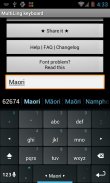




Maori Keyboard Plugin

Maori Keyboard Plugin介绍
Maori Dictionary plugin for Multiling O Keyboard autocorrect and word prediction
Instruction:
⑴ Install this plugin and Multiling O Keyboard. https://play.google.com/store/apps/details?id=kl.ime.oh
⑵ Run O Keyboard and follow its setup guide.
⑶ Slide space bar to switch languages.
If you have font issue, read this: http://honsoapps.appspot.com/1/ma.html
Wikipedia:
Maori or Māori (/ˈmaʊri/; Māori pronunciation: [ˈmaː.ɔ.ɾi]) is an Eastern Polynesian language spoken by the Māori people, the indigenous population of New Zealand. Since 1987, it has been one of New Zealand's official languages. It is closely related to Cook Islands Māori, Tuamotuan, and Tahitian.
According to a 2001 survey on the health of the Māori language, the number of very fluent adult speakers was about 9% of the Māori population, or 30,000 adults.[1] A national census undertaken in 2006 says that about 4% of the New Zealand population,[4] or 23.7% of the Maori population could hold a conversation in Maori about everyday things
Name
The English word comes from the Maori language, where it is spelled "Māori". In New Zealand the Maori language is commonly referred to as Te Reo [tɛ ˈɾɛ.ɔ] "the language", short for te reo Māori.
The spelling "Maori" (without macron) is standard in English outside New Zealand in both general[6] and linguistic[7] usage. The Maori-language spelling "Māori" (with macron) has become common in New Zealand English in recent years, particularly in Maori-specific cultural contexts,[8][9] although the traditional English spelling is still prevalent in general media and government use.[10][11]
Preferred and alternate pronunciations in English vary by dictionary, with /ˈmaʊəri/ being most frequent today, and /mɑːˈɒri/, /ˈmɔri/, and /ˈmɑri/ also given.[12] Spelling pronunciations as /meɪˈɔəri/ are also encountered in popular speech[13][14] in the United States particularly, but are considered incorrect.
Official status
New Zealand has three official languages – English, Māori and New Zealand Sign Language.[15] Māori gained this status with the passing of the Māori Language Act in 1987.[16] Most government departments and agencies have bilingual names; for example, the Department of Internal Affairs Te Tari Taiwhenua, and places such as local government offices and public libraries display bilingual signs and use bilingual stationery. New Zealand Post recognises Māori place-names in postal addresses. Dealings with government agencies may be conducted in Māori, but in practice, this almost always requires interpreters, restricting its everyday use to the limited geographical areas of high Māori fluency, and to more formal occasions, such as during public consultation.
An interpreter is on hand at sessions of Parliament, in case a Member wishes to speak in Māori. In 2009, Opposition parties held a filibuster against a local government bill, and those who could recorded their voice votes in Māori, all faithfully interpreted.[17]
A 1994 ruling by the Privy Council[18] in the United Kingdom held the New Zealand Government responsible under the Treaty of Waitangi (1840) for the preservation of the language. Accordingly, since March 2004, the state has funded Māori Television, broadcast partly in Māori. On 28 March 2008, Māori Television launched its second channel, Te Reo, broadcast entirely in the Māori language, with no advertising or subtitles. In 2008, Land Information New Zealand published the first list of official place names with macrons, which indicate long vowels. Previous place name lists were derived from systems (usually mapping and GIS systems) that could not handle macrons
</div> <div jsname="WJz9Hc" style="display:none">毛利人的词典插件Multiling o键盘自动更正和单词预测
说明:
⑴安装此插件和Multiling o键盘。 https://play.google.com/store/apps/details?id=kl.ime.oh
⑵运行o键盘,并按照其设置指南。
⑶滑空格键切换语言。
如果您有问题的字体,阅读:http://honsoapps.appspot.com/1/ma.html
维基百科:
毛利或毛利(/maʊri/;毛利发音:[maː.ɔ.ɾi])是一种东方语言波利尼西亚的毛利人,新西兰的土著居民讲话。自1987年以来,它一直是新西兰的官方语言之一。这是密切相关的库克群岛毛利,Tuamotuan和大溪地。
根据对毛利语的健康2001年的调查中,很流利的成人扬声器的数量约为9%的毛利人口,或30,000名成人。[1]在2006年进行的一项全国人口普查说,约4%的新新西兰人口,[4]或毛利人口的23.7%,可容纳在一个毛利约谈话日常事物
名字
英文单词来源于毛利语,它是拼写“毛利”。在新西兰毛利人的语言通常被称为特雷奥[tɛɾɛ.ɔ]“语言”,简称REO德毛利。
拼写“毛利人”(不带长音符号)的标准在新西兰以外的英语一般都[6]和语言[7]的使用。毛利人的语言拼写“毛利人”(与长音)已成为普遍在新西兰英语,近年来,特别是在毛利人特有的文化背景,[8] [9]虽然传统的英文拼写仍然是在大众媒体和政府普遍使用。[10] [11]
优选和英语交替发音返程词典,与/maʊəri/是最频繁的今天,和/mɑːɒri/,/mɔri/和/mɑri/给出。[12]拼写发音为/meɪɔəri/也会遇到在流行的语音[13] [14]在美国特别地,但被认为是不正确。
官方地位
新西兰有三种官方语言 - 英语,毛利和新西兰手语[15]毛利人获得此地位的传球毛利语法于1987年[16]大多数政府部门和机构有双语名称。例如,内务部特塔里Taiwhenua,以及诸如当地政府部门和公共图书馆展示场所双语标志和使用双语文具。新西兰邮政承认毛利地名的邮寄地址。交往与政府机构可以在毛利人进行,但在实践中,这几乎总是需要翻译,制约了其日常使用的高毛利流畅有限的地理区域,并以比较正式的场合,如公众咨询期间。
一个解释是手头上的议会会议上,万一有议员想在毛利人说话。 2009年,反对党举行反对当地政府法案的阻挠,如果谁能够在毛利人记录他们的声音票,所有忠实的解释。[17]
1994年的一项裁决枢密院[18]在英国举行的新西兰政府根据怀唐伊(1840)的条约负责语言的保存。因此,自2004年3月,国家出资的毛利电视台,广播部分毛利。 2008年3月28日,毛利电视台推出了其第二个通道,特雷奥,完全在毛利语广播,没有广告或字幕。 2008年,新西兰土地信息发布的官方地名与macrons,这表明长元音的第一个列表。上一页地名名单来源于系统(通常制图和GIS系统)无法处理macrons</div> <div class="show-more-end">





















